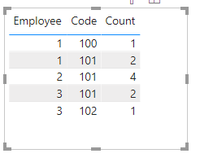- Power BI forums
- Updates
- News & Announcements
- Get Help with Power BI
- Desktop
- Service
- Report Server
- Power Query
- Mobile Apps
- Developer
- DAX Commands and Tips
- Custom Visuals Development Discussion
- Health and Life Sciences
- Power BI Spanish forums
- Translated Spanish Desktop
- Power Platform Integration - Better Together!
- Power Platform Integrations (Read-only)
- Power Platform and Dynamics 365 Integrations (Read-only)
- Training and Consulting
- Instructor Led Training
- Dashboard in a Day for Women, by Women
- Galleries
- Community Connections & How-To Videos
- COVID-19 Data Stories Gallery
- Themes Gallery
- Data Stories Gallery
- R Script Showcase
- Webinars and Video Gallery
- Quick Measures Gallery
- 2021 MSBizAppsSummit Gallery
- 2020 MSBizAppsSummit Gallery
- 2019 MSBizAppsSummit Gallery
- Events
- Ideas
- Custom Visuals Ideas
- Issues
- Issues
- Events
- Upcoming Events
- Community Blog
- Power BI Community Blog
- Custom Visuals Community Blog
- Community Support
- Community Accounts & Registration
- Using the Community
- Community Feedback
Register now to learn Fabric in free live sessions led by the best Microsoft experts. From Apr 16 to May 9, in English and Spanish.
- Power BI forums
- Forums
- Get Help with Power BI
- Desktop
- Power bi dates diff conditional count
- Subscribe to RSS Feed
- Mark Topic as New
- Mark Topic as Read
- Float this Topic for Current User
- Bookmark
- Subscribe
- Printer Friendly Page
- Mark as New
- Bookmark
- Subscribe
- Mute
- Subscribe to RSS Feed
- Permalink
- Report Inappropriate Content
Power bi dates diff conditional count
I am new to power bi and i need to count the number of times that a employee has the same issue code in less than 50 days.
Employee | Code | Date
01 | 101 | mm/dd/yyyy
02 | 101 | mm/dd/yyyy
03 | 101 | mm/dd/yyyy
02 | 101 | mm/dd/yyyy
01 | 100 | mm/dd/yyyy
03 | 101 | mm/dd/yyyy
03 | 102 | mm/dd/yyyy
I tried to get the days using datediff but im not so sure how to implement the conditionals to count that.
Solved! Go to Solution.
- Mark as New
- Bookmark
- Subscribe
- Mute
- Subscribe to RSS Feed
- Permalink
- Report Inappropriate Content
Hi, @Compacted
As you said, if your data sets are less than 50 days, you can count directly.
1. Calculated column
Count =
CALCULATE (
COUNT ( 'Table'[ Code ] ),
FILTER (
'Table',
'Table'[Employee ] = EARLIER ( 'Table'[Employee ] )
&& 'Table'[ Code ] = EARLIER ( 'Table'[ Code ] )
)
)
2. Measure
Measure =
CALCULATE (
COUNT ( 'Table'[ Code ] ),
FILTER (
ALL ( 'Table' ),
'Table'[Employee ] = MAX ( 'Table'[Employee ] )
&& 'Table'[ Code ] = MAX ( 'Table'[ Code ] )
)
)
Best Regards,
Community Support Team _Charlotte
If this post helps, then please consider Accept it as the solution to help the other members find it more quickly.
- Mark as New
- Bookmark
- Subscribe
- Mute
- Subscribe to RSS Feed
- Permalink
- Report Inappropriate Content
Hi, @Compacted
As you said, if your data sets are less than 50 days, you can count directly.
1. Calculated column
Count =
CALCULATE (
COUNT ( 'Table'[ Code ] ),
FILTER (
'Table',
'Table'[Employee ] = EARLIER ( 'Table'[Employee ] )
&& 'Table'[ Code ] = EARLIER ( 'Table'[ Code ] )
)
)
2. Measure
Measure =
CALCULATE (
COUNT ( 'Table'[ Code ] ),
FILTER (
ALL ( 'Table' ),
'Table'[Employee ] = MAX ( 'Table'[Employee ] )
&& 'Table'[ Code ] = MAX ( 'Table'[ Code ] )
)
)
Best Regards,
Community Support Team _Charlotte
If this post helps, then please consider Accept it as the solution to help the other members find it more quickly.
- Mark as New
- Bookmark
- Subscribe
- Mute
- Subscribe to RSS Feed
- Permalink
- Report Inappropriate Content
@Compacted Assuming you put Employee and Code into a table visual you could use this measure:
Measure =
VAR __Employee = MAX('Table'[Employee])
VAR __Code = MAX('Table'[Code])
VAR __LastDate = MAX('Table'[Date])
VAR __MinDate = __LastDate - 50
RETURN
COUNTROWS(FILTER('Table',[Date]>=__LastDate))@ me in replies or I'll lose your thread!!!
Instead of a Kudo, please vote for this idea
Become an expert!: Enterprise DNA
External Tools: MSHGQM
YouTube Channel!: Microsoft Hates Greg
Latest book!: The Definitive Guide to Power Query (M)
DAX is easy, CALCULATE makes DAX hard...
- Mark as New
- Bookmark
- Subscribe
- Mute
- Subscribe to RSS Feed
- Permalink
- Report Inappropriate Content
Hey thanks for the help, i've tried using the solution above but it keeps returning ones in every row, and in the end the total is just the number of rows. There are 10 cases that are less than 50 days in the dataset that i am using so i was expecting to see something similar as the count result.
Helpful resources

Microsoft Fabric Learn Together
Covering the world! 9:00-10:30 AM Sydney, 4:00-5:30 PM CET (Paris/Berlin), 7:00-8:30 PM Mexico City

Power BI Monthly Update - April 2024
Check out the April 2024 Power BI update to learn about new features.

| User | Count |
|---|---|
| 111 | |
| 100 | |
| 80 | |
| 64 | |
| 58 |
| User | Count |
|---|---|
| 148 | |
| 111 | |
| 93 | |
| 84 | |
| 66 |



